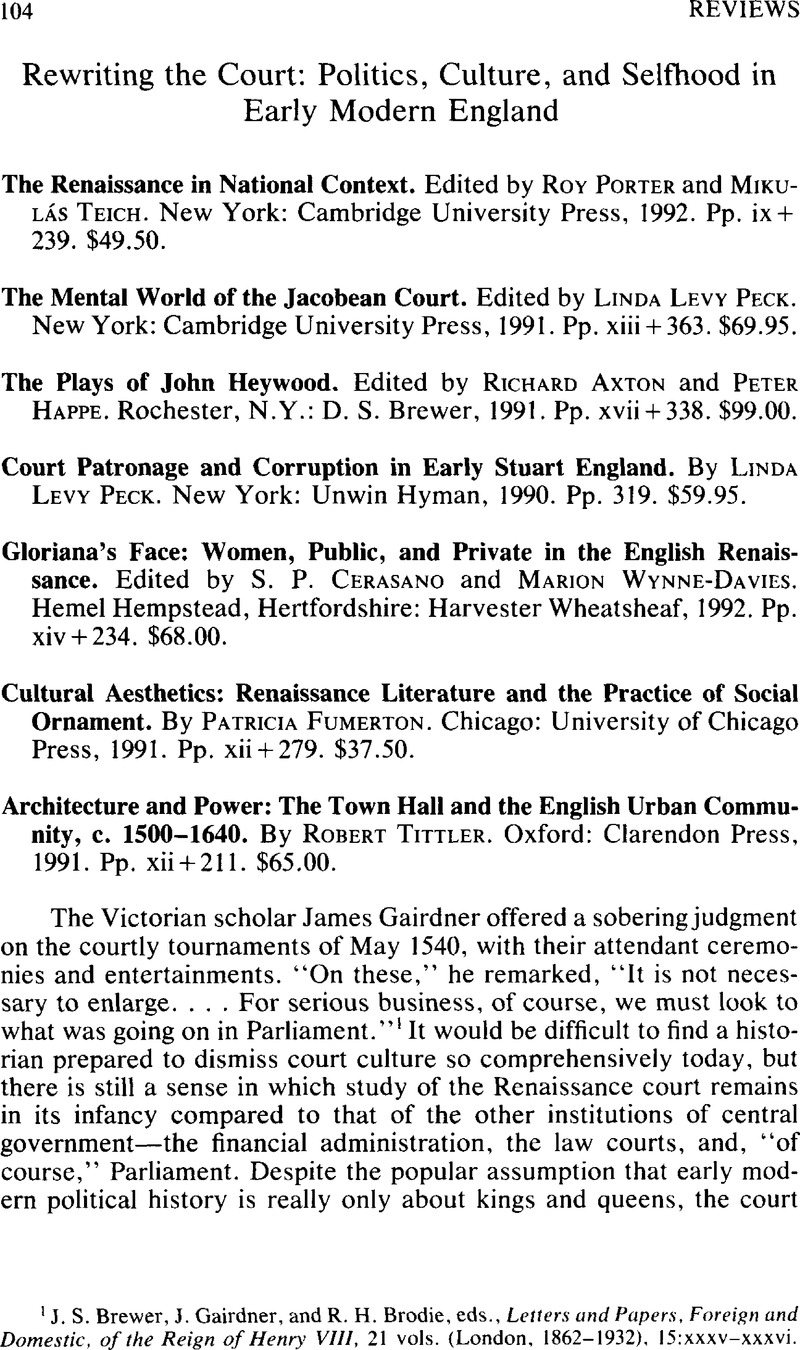No CrossRef data available.
Article contents
Rewriting the Court: Politics, Culture, and Selfhood in Early Modern England - The Renaissance in National Context. Edited by Roy Porter and Mikulás Teich. New York: Cambridge University Press, 1992. Pp. ix + 239. $49.50. - The Mental World of the Jacobean Court. Edited by Linda Levy Peck. New York: Cambridge University Press, 1991. Pp. xiii + 363. $69.95. - The Plays of John Heywood. Edited by Richard Axton and Peter Happe. Rochester, N.Y.: D. S. Brewer, 1991. Pp. xvii + 338. $99.00. - Court Patronage and Corruption in Early Stuart England. By Linda Levy Peck. New York: Unwin Hyman, 1990. Pp. 319. $59.95. - Gloriana's Face: Women, Public, and Private in the English Renaissance. Edited by S. P. Cerasano and Marion Wynne-Davies. Hemel Hempstead, Hertfordshire: Harvester Wheatsheaf, 1992. Pp. xiv + 234. $68.00. - Cultural Aesthetics: Renaissance Literature and the Practice of Social Ornament. By Patricia Fumerton. Chicago: University of Chicago Press, 1991. Pp. xii + 279. $37.50. - Architecture and Power: The Town Hall and the English Urban Community, c. 1500–1640. By Robert Tittler. Oxford: Clarendon Press, 1991. Pp. xii + 211. $65.00.
Published online by Cambridge University Press: 10 January 2014
Abstract

- Type
- Reviews
- Information
- Copyright
- Copyright © North American Conference of British Studies 1994
References
1 Brewer, J. S., Gairdner, J., and Brodie, R. H., eds., Letters and Papers, Foreign and Domestic, of the Reign of Henry VIII, 21 vols. (London, 1862–1932), 15:xxxv–xxxvi.Google Scholar
2 An exception would be the pioneering description of the Elizabethan court in Chambers, E. K., The Elizabethan Stage, 4 vols. (Oxford, 1923)Google Scholar.
3 See, e.g., the essays by Malcolm Smuts, Leeds Barroll, and J. H. M. Salmon in Levy Peck, ed., The Mental World. The ongoing debate about the possibility of ideological conflict in early modern society is usefully summarized and exemplified by the contrasting essays by Jenny Wormald, J. P. Sommerville, and Paul Christianson in the same volume. The debate is also joined, from an unexpected angle, by Annabel Patterson's illuminating essay on the anxieties of John Donne's politics (ibid., pp. 251–72) and, more directly, by Levy Peck's own monograph, considered below.
4 The “popular style” was clearly also a courtly mode, a point the editors acknowledge in noting that “Henrician Court taste clearly countenanced a liking for double entendre and a good deal of grossness” (p. 13). The notion of a purely refined Tudor “courtly taste” remains, however, as persistent as it is curious. Thus, scholars who have little difficulty in acknowledging that Cardinal Morton's household (the young Thomas More et al.) could enjoy Henry Medwall's Fulgens and Lucres, with its obscene game of “farte pryke in cule” (see Nelson, Alan H., ed., The Plays of Henry Medwall [Woodbridge, 1980])Google Scholar, still balk at the idea of less ribald plays appearing at the secular court.
5 See Elton, G. R., “Tudor Government: The Points of Contact, III. The Court,” Transactions of the Royal Historical Society 26 (1976): 211–28CrossRefGoogle Scholar; and, for the notion of “sophisticated leisure,” Javitch, Daniel, Poetry and Courtliness in Renaissance England (Princeton, N.J., 1978), p. 3Google Scholar.
6 Such patriarchal models are themselves usefully investigated in the essays by Laurie E. Maguire, Georgianna Zeigler, Barbara J. Bono, and Cerasano herself in the same volume.
7 See, e.g., Girouard, M., Life in the English Country House (London, 1978)Google Scholar; Starkey, D. R., “The King's Privy Chamber, 1485–1547” (Ph.D. diss., Cambridge University, 1973)Google Scholar, and “Intimacy and Innovation: The Rise of the Privy Chamber, 1485–1547,” in The English Court from the Wars of the Roses to the Civil War, Starkey, D., Morgan, D. A. L., Murphy, John, Wright, Pam, Cuddy, Neil, and Sharpe, Kevin (London and New York, 1987)Google Scholar.




